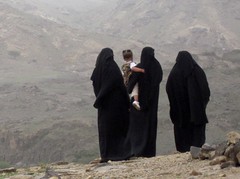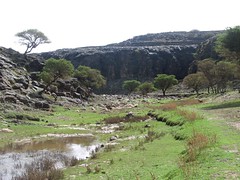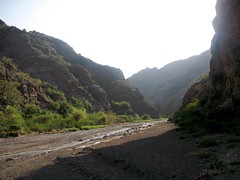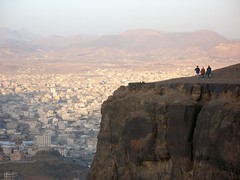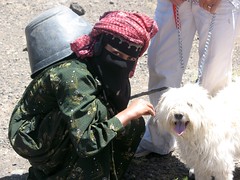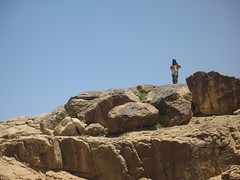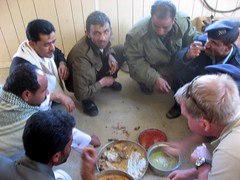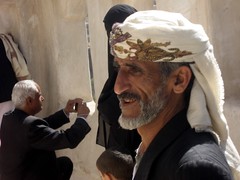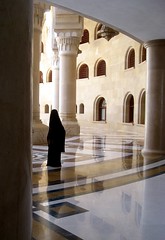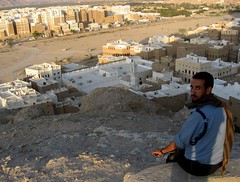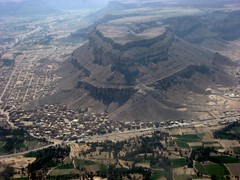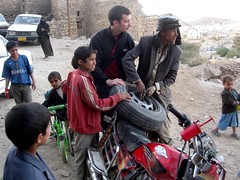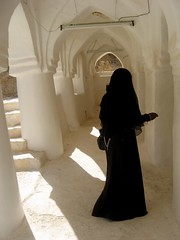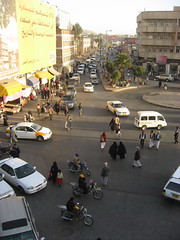The Mahktan Dams are northwest of Sanaa, not far from the US embassy. There are two small check points on the way, but Paul was able to talk his way through them. The second dam is at the end of a wadi, which after walking for about 10 minutes forks into two wadis. It's been raining a lot recently and there was a small flowing stream in the wadi on the right side. It was filled with frog eggs and small tadpoles. We also saw two enormous frogs. We followed the rocky stream almost to the end, then climbed up and over the steep ridge and down to the second wadi. An excellent hike. The area is very popular with locals, especially in the rainy season when grass and flowers and small thorny plants the goats don't eat erupt from the dry soil and rock. As we walked back to the car, we passed many groups of people, including these veiled women and small child.
Tuesday, May 11, 2010
Sunday, April 18, 2010
Wadi Hadoor for the 15 April bird walk run by the Sanaa Ornithological Club
The Sanaa Ornithological Club, run by David Stanton, organizes talks and walks once a month. The presentations (ranging from movies to illustrated lectures) are held second Tuesdays at 7:30 PM at the YSPW Hall (Yemen Society for the Protection of Wildlife, on Algeria Street). The walks are held the following Thursday morning, often leaving as early as 7 AM. David takes us to various interesting places around Sanaa, usually within the security perimeter.
This past Thursday, April 15, we explored Wadi Hadoor, a 45 minute drive north west of Sanaa. Majestic! A lovely walk along a flat wadi floor bounded by sheer rock cliffs sprouting green clumps of varied vegetation. It had rained heavily the day before, leaving muddy ponds, an unusual sight in Yemen.
David’s getting better at selecting places where birders can bird and hikers hike. Although officially a birding club, these monthly walks draw people with varied interests. Kathy brought her sketchbook and was thrilled to find an interesting tree growing sideways from a muddy bank to sketch. Ingo, armed with bottles and a rake and suction devises, discovered a new species of beetle. Mats and Rosanna brought their dogs Olga and Amy and all were quite pleased to have a low-key, flat walk (most weeks they scramble up and over steep wadi walls).
Sarah, talking to one of the young Yemeni YSPW employees, recorded in a small notebook the Arabic names of things she saw. Roberto, prevented by his employer from driving through security checkpoints, was simply pleased get out of the city (Wadi Hadoor is accessible without a tasreya). I found a complete dog skull and the upper part of a cat skull.
Wadi Hadoor is a 45 minute drive from Sanaa, to the right when heading northwest on the Kawkaban / Shibam / Thula road. Contact David Stanton at david@yemenileopard.org for more information about the Sanaa Ornithological Club or to learn about his efforts to protect the endangered Arabian Leopard.
This past Thursday, April 15, we explored Wadi Hadoor, a 45 minute drive north west of Sanaa. Majestic! A lovely walk along a flat wadi floor bounded by sheer rock cliffs sprouting green clumps of varied vegetation. It had rained heavily the day before, leaving muddy ponds, an unusual sight in Yemen.
David’s getting better at selecting places where birders can bird and hikers hike. Although officially a birding club, these monthly walks draw people with varied interests. Kathy brought her sketchbook and was thrilled to find an interesting tree growing sideways from a muddy bank to sketch. Ingo, armed with bottles and a rake and suction devises, discovered a new species of beetle. Mats and Rosanna brought their dogs Olga and Amy and all were quite pleased to have a low-key, flat walk (most weeks they scramble up and over steep wadi walls).
Sarah, talking to one of the young Yemeni YSPW employees, recorded in a small notebook the Arabic names of things she saw. Roberto, prevented by his employer from driving through security checkpoints, was simply pleased get out of the city (Wadi Hadoor is accessible without a tasreya). I found a complete dog skull and the upper part of a cat skull.
Wadi Hadoor is a 45 minute drive from Sanaa, to the right when heading northwest on the Kawkaban / Shibam / Thula road. Contact David Stanton at david@yemenileopard.org for more information about the Sanaa Ornithological Club or to learn about his efforts to protect the endangered Arabian Leopard.
Tuesday, April 13, 2010
Two women in black baltos on a Fun City ride
We took the kids to Fun City on Wednesday morning, the last day before spring break. A variety of other schools were also there, but the park was closed to the public. We paid a set price per child and they (as well as teachers) could ride every ride that was open as often as they wished. For lunch we ordered pizza and a drink. In total it cost about US $6 per person.
I brought my camera to record my students for the benefit of the parents. But I found the images of balto-clad women riding the ferris wheel more striking.
I brought my camera to record my students for the benefit of the parents. But I found the images of balto-clad women riding the ferris wheel more striking.
Monday, April 12, 2010
Wadi Siham in the spring
You can walk through water in Wadi Siham. It’s the only wadi I know near Sana'a where you can do so. Warm water bubbles to the surface from a collection of small springs and trickles along the flat wadi floor until it disappears back into the earth a few kilometers later. On Friday afternoons the upper part of the wadi is filled with picnicking Yemeni families, children splashing gleefully in the water.
The springs are called Hammam Jarif. They are 30 km south of Sanaa, but are within the security perimeter, so permission is not required. To get there, turn right off the Taiz Rd at the *Jarif Spa* sign (you will pass several villages after leaving Sanaa proper. If you get to a checkpost, you have gone too far).
Follow the paved road down down down into the valley, 1000 meters below. Keep going road until the road turns from asphalt to dirt. Drive past a collection of small stone huts over the springs to the mouth of the Wadi. If you have a four-wheel drive, you can drive into the wadi along a rough, rocky track. I was told it's possible to drive all the way to the Red Sea.
Wadi Siham is a wonderful place to camp. We woke early and Paul was able to be in his office by 8:30 AM.
The springs are called Hammam Jarif. They are 30 km south of Sanaa, but are within the security perimeter, so permission is not required. To get there, turn right off the Taiz Rd at the *Jarif Spa* sign (you will pass several villages after leaving Sanaa proper. If you get to a checkpost, you have gone too far).
Follow the paved road down down down into the valley, 1000 meters below. Keep going road until the road turns from asphalt to dirt. Drive past a collection of small stone huts over the springs to the mouth of the Wadi. If you have a four-wheel drive, you can drive into the wadi along a rough, rocky track. I was told it's possible to drive all the way to the Red Sea.
Wadi Siham is a wonderful place to camp. We woke early and Paul was able to be in his office by 8:30 AM.
Sunday, April 11, 2010
Sanaa Hash (March, 2010)
The Sana'a Hash meets at different points around Sanaa every Monday afternoon at 4:15. We drive as a convoy to a nearby location and hike, inevitably climbing a steep mountain side at some point. The views from the top usually make the climb worthwhile.
Few of the traditional Hash customs are followed: a bottle of water is offered at the end, but no alcohol. There is no on-on, so people tend to disperse afterwards. It is always set by the same person (a former Yemeni army captain), who knows lots of different places to explore within the Sanaa security perimeter (I’ve never been on exactly the same Hash twice). Occasionally weekend trips are arranged, (but the Hash does not help foreign Hashers get the required security forms (tasreiyah).
To get on the Sanaa Hash mailing list, email Randall at: randallcameron@kpmg.com.ye
Few of the traditional Hash customs are followed: a bottle of water is offered at the end, but no alcohol. There is no on-on, so people tend to disperse afterwards. It is always set by the same person (a former Yemeni army captain), who knows lots of different places to explore within the Sanaa security perimeter (I’ve never been on exactly the same Hash twice). Occasionally weekend trips are arranged, (but the Hash does not help foreign Hashers get the required security forms (tasreiyah).
To get on the Sanaa Hash mailing list, email Randall at: randallcameron@kpmg.com.ye
Saturday, April 10, 2010
Wadi Hamel 03 - A shepherdess, Olga (the dog) and Rosanna
I could see the smile in the eyes of the young shepherdess who squatted down to interact with Olga, the little furry white dog. Unlike many veiled females, the girl was quite willing to be photographed. We met her and another girl on the ridge, high above the wadi. Each was covered entirely, aside from a narrow slit in the cloth to see out of. They carried buckets and little sticks to help them tend the goats.
Wadi Hamel 02: Plowing fields for spring rains
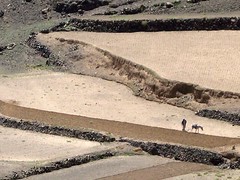
A man and his donkey plowing a field for planting (Wadi Hamel, Yemen, April 2010)
Originally uploaded by Kate B Dixon
We left their house in south Sanaa at a little past 8:30 on Thursday morning. (Adel, the young driver was late). Less than 30 minutes later the dogs were out of their cage and we walked past a group of veiled women washing clothes at a disel powered pump. An old man leaning against a tree called out to us as we passed, heading up the narrow wadi. So many trees! lovely.
No people aside from a young man who passed us quickly. We walked until the Wadi split into two and scrambled up the steep rocky cliffs to a ridge and could look down to the other side. Below in the valley, small terraced plots, carefully tended.
An old man plowing one with a donkey.
Wadi Hamel 01: Mats poses with two boys holding their photos
We walked past the entrance to a cliff-perched village and down into the carefully tended fields. At a large tree, Mats stopped and watered the dogs. Another, younger shepherdess watched us from a rocky wall. And then, from up in the village, the boys spied us. They raced down the path and arrived, panting and laughing. Mats gave them the photos, one for each boy. They were pleased.
Thursday, February 18, 2010
#10 Lunch with guards at a checkpoint (near Sanaa, Yemen, Feb 2010)
Paul and I explored last Thursday, our weekend. We drove north and then west until the check point near Wadi Dhahr. Paul tried his best to talk our way through, but to no avail. The guards were friendly, but steadfast in their refusal to let us pass. But they invited us to lunch.
Saturday, February 6, 2010
# 9 On the roof of Dar al-Hajar (Palace on the Rock), Wadi Dhahr, Yemen
On the roof of Dar al-Hajar (Palace on the Rock), Wadi Dhahr, Yemen
Originally uploaded by Kate B Dixon
Originally uploaded by Kate B Dixon
The *castle-on-the-rock* in Wadi Dhahr is within the Sanaa security perimeter, so one can drive there without permission. I drove there on a Friday morning with a young French woman who opted to ignore her oil company’s order not to go without a body guard. I was rather surprized to see so many local tourists enjoying the view and snapping photos on the roof of the palace. On the plaza below men and boys danced the traditional jimbaya wedding dance to the beat of drums.
Friday, February 5, 2010
#8: A veiled woman in al-Saleh Mosque
The International Women’s Association trip to the controversial al-Saleh Mosque was on Thursday morning, so I could go (Friday is the muslim sabbath, so weekends here are Thur-Fri).
“You mean the mosque built on money stolen from the people of Yemen”, Tanya yelled when I mentioned that I was going.
“Think of how many clinics and schools that would pay for,” she continued. “Only the president’s cronies would be caught dead there.”
Quite a few people in Yemen consider the mosque to be an abomination, the expense a huge drain on a poor country. But others consider the al-Saleh Mosque to be a *national wonder of Yemen*.
Named after President Ali Abdullah Saleh, the mosque was opened during Ramadan in 2008.
According to the Yemen Observer, it cost US $60 million and was “built on the president’s expense” http://www.yobserver.com/news-varieties/10014876.html
It’s said to be the most decorated mosque in the world, Mohammed, our articulate guide told us. Most of the materials used to build it are from Yemen, though some of the marble is Italian. Six tall minarets in the Turkish style. (Traditionally minarets of mosques in Yemen are much shorter.)
The huge, multi domed structure, an island glowing white in a sea of bright green grass, the largest expanse of green I have ever seen in Yemen. Inside, a massive space, dark and cool. Colored patches floating on the thick, soft carpet from bright sun through colored glass. Soaring ceilings, brightly painted domes, intricate carvings.
Aside from our group and the accompanying guards, the mosque was almost empty. A lone man praying. Young men polishing and pushing mops. Veiled women who quietly approached us, offering brochures, booklets, and CDs promoting Islam.
Silent, gleaming elevators whisked us up to the women’s section, hidden behind a double set of ornately carved wooden screens, making it difficult to see below.
Three of the fully veiled women who accompanied us knelt on the thick, deep red carpet, and one of them chanted verses from the Koran in a lovely, melodious voice.
“Twenty women of this mosque know the entire Koran in here,” a woman said, touching her heart, “and twenty more know half of it. “We must preserve it in it’s true form, not even a single letter can be changed,”
“You mean the mosque built on money stolen from the people of Yemen”, Tanya yelled when I mentioned that I was going.
“Think of how many clinics and schools that would pay for,” she continued. “Only the president’s cronies would be caught dead there.”
Quite a few people in Yemen consider the mosque to be an abomination, the expense a huge drain on a poor country. But others consider the al-Saleh Mosque to be a *national wonder of Yemen*.
Named after President Ali Abdullah Saleh, the mosque was opened during Ramadan in 2008.
According to the Yemen Observer, it cost US $60 million and was “built on the president’s expense” http://www.yobserver.com/news-varieties/10014876.html
It’s said to be the most decorated mosque in the world, Mohammed, our articulate guide told us. Most of the materials used to build it are from Yemen, though some of the marble is Italian. Six tall minarets in the Turkish style. (Traditionally minarets of mosques in Yemen are much shorter.)
The huge, multi domed structure, an island glowing white in a sea of bright green grass, the largest expanse of green I have ever seen in Yemen. Inside, a massive space, dark and cool. Colored patches floating on the thick, soft carpet from bright sun through colored glass. Soaring ceilings, brightly painted domes, intricate carvings.
Aside from our group and the accompanying guards, the mosque was almost empty. A lone man praying. Young men polishing and pushing mops. Veiled women who quietly approached us, offering brochures, booklets, and CDs promoting Islam.
Silent, gleaming elevators whisked us up to the women’s section, hidden behind a double set of ornately carved wooden screens, making it difficult to see below.
Three of the fully veiled women who accompanied us knelt on the thick, deep red carpet, and one of them chanted verses from the Koran in a lovely, melodious voice.
“Twenty women of this mosque know the entire Koran in here,” a woman said, touching her heart, “and twenty more know half of it. “We must preserve it in it’s true form, not even a single letter can be changed,”
#7: My armed guard above Shibam, Yemen (Dec 2010)
The guard was not my choice or request. He came with me when I left the Seiyun Airport, and for two days accompanied me wherever I was driven
I emailed two dynamic women I met on a Sanaa Ornithological Club trip, hoping to join them on a hike to Bayt Baws or Wadi Dhahr. Unfortunately one wrote back to say they were leaving. Order came down from top of oil company X: Spouses leave Yemen now. Two dynamic women I met on a Sanaa bird club trip are already gone. Karen postponed her ticket twice; is now leaving Saturday. She does not want to leave, but is being forced to. The company will pay for the hotel in another country for as long as needed.
I learned Wednesday night that the order is not due to any change in the security situation here. Rather, the chief learned that certain security measures had not been installed as ordered. He wanted to punish.
I emailed two dynamic women I met on a Sanaa Ornithological Club trip, hoping to join them on a hike to Bayt Baws or Wadi Dhahr. Unfortunately one wrote back to say they were leaving. Order came down from top of oil company X: Spouses leave Yemen now. Two dynamic women I met on a Sanaa bird club trip are already gone. Karen postponed her ticket twice; is now leaving Saturday. She does not want to leave, but is being forced to. The company will pay for the hotel in another country for as long as needed.
I learned Wednesday night that the order is not due to any change in the security situation here. Rather, the chief learned that certain security measures had not been installed as ordered. He wanted to punish.
Thursday, February 4, 2010
# 6: The British Club
The British Club
Went to the members only British club last night with David. It’s one of few places to drink (alcohol) in Sana’a, and is not far from home. You can buy very expensive drinks at the Movenpik, Sheraton or Russian club, but these places are far over on the northeast part of town.
The British Club is a community, as well as a place to eat and drink. After going a few times, you’ll see familiar people, some of whom will buy you drink. There are dart matches and quiz nights, a good lending library, a pool table, and a small, cold swimming pool I’ve seen but never sampled.
There is an application fee to join and you must show your photo ID to enter. Security is tight. Knock on an unmarked black gate, be inspected by the guard, enter, and wait as he unlocks the door to the club. Drinks aren’t expensive and there is plenty to choose from. The food, including bacon and gammon steak, is good.
Women are a minority. By Yemen law, Yemenis are not allowed to join. Most members are connected to oil or to an embassy, but there are a few other teachers and NGO types.
Tuesday, February 2, 2010
Monday, February 1, 2010
# 4 Flat tire in Bayt Baws
Flat tire in Bayt Baws #1 (Jan 2010)
Originally uploaded by Kate B Dixon
Originally uploaded by Kate B Dixon
The chap in the hat is strapping the flat tire to his motor bike so he could take it off to get fixed. Vincent, the guy in the black jacket, I met through a posting to a Flickr group. I love when online becomes in-person!
Sunday, January 31, 2010
# 3 - Morning commute to work
Driving west toward Hadaa St
West on Zobairi toward the Hodeida Rd.
Heading west, up the mountain, past the Egyptian Memorial and the Chinese cemetary
Up, up, up my little car chugs
And then down again, toward school
Saturday, January 30, 2010
# 2 - Veiled Women
Shoe shopping - Intesar, her husband David and baby Akram (Sana’a, Yemen, Jan 2010)
A woman in a *setarrah*, a large piece of fabric brightly died in red, blue, green and yellow,. The setarrah is going out of fashion as most women, at least in Sana’a, are converting to the all encompassing black balto http://www.yobserver.com/news-varieties/10012842.html
Medina in black enjoying the view from the remains of a stone fort in Wadi Hadramawt (Sept, 2010)
As the above photos indicate, women in Yemen cover themselves, in an extreme way. No flesh visible aside from the eyes and the bridge of the nose. Sometimes the hands, though these can be tucked inside the balto. Sometimes the eyes are covered as well.
Friday, January 29, 2010
Photo-a-Day: Yemen
I think I shall re-name this blog *photo-a-day: yemen*. this will require commitment, however. Am I up to it?
9:14 on fri evening. Tomorrow the school week starts and I would like to finish instructions on making a book report before I sleep. Plus get my pack lunch together and tidy up.
Stopped by Dave’s place this evening. His young wife, a conservative young woman from a small Yemeni village, held baby Akram well bundled in a blanket in her lap. As a veiled woman she was uncomfortable, unable to be in the same room as a man not her husband, so she did not accompany us to Sam’s.
Sam smokes Rothmans and took me into his daughters room to see this shelf made entirely of empty Rothmans cigarette packs glued together. On the drive home I snapped a photo of the al-Saleh mosque, blurry as I was driving quickly.
Thursday, January 28, 2010
Henna after lunch
Saleh, my driver in Wadi Hadramawt, brought me to his home in the middle after the day, when the sun is bright and everything slows down. We had spent the morning exploring al-Kathiri Palace in Seiyun, and some crumbling palaces and the famous library in the nearby town of Tarim, and wanted to wait until late afternoon, when the light is better for photographs, before going to Shibam.
After admiring his father’s impressive classic car collection, I was invited upstairs for lunch. The women and children and I sat cross legged in a spacious room, no furniture but numerous pillows stacked against the wall. Presently food was brought in for me on a large tin tray. I felt a bit self conscious eating alone, but ate happily - a succulent piece of grilled tuna, rice, salad of thinly sliced carrots and tomatoes, a bowl of stewed vegetables. Delicious.
Presently, Medina arrived and slowly prepared the henna as she chatted with the other women. I ate and smiled, and watched Medina mix the dark powder with a bit of water in a small bowl, then spoon it into a cone of plastic cut from a plastic bag, tipped with a bit of electric tape. When I had finished eating and cone was filled, she piped delicate designs of leaves and vines on my hands and wrists, front and back. Saleh’s wife nursed the baby boy, then fed him bits of boiled potato mashed with her fingers. The girls watched and giggled. The young mother shifted the baby and dabbed the designs with sliced lemon. The henna formed a thick crust which I scraped off hours later back at the hotel. The delicate designs remained for ten days or so before fading away.
Medina was not interested in visiting Shibam that afternoon, but agreed to accompany me to the Shrine of the Prophet Hud the next morning.
Monday, January 25, 2010
Ta'izz, from Qalat al-Qahira (Cairo Castle)
A veiled woman and her uniformed sons look at Ta'izz
One weekend in October, Chrissy and I were driven to Ta'izz, a trip arranged through Universal Touring Company. Mohammed, our driver, was a friendly chap who spoke some English and paused each afternoon to buy qat. Ta'izz is a large town between Sana'a and Aden, set amidst rugged mountains. Mohammed drove us up to the Qalat al-Qahira (Cairo Castle) high above the town. It was a long trek up from where he could park, but the view was majestic.
Friday, January 22, 2010
Bayt Baws (350 words)






Bayt Baws, a crumbling ghost town crowning a rock island 7 km south of Sanaa, provided a well protected home when it was a living city years ago. The single entrance, a massive stone gate, is still intact, though the wooden door, once closed at dusk, is long gone. Closely packed, multistoried homes of stone are built to the very edge of sheer cliffs, surely an insurmountable barrier.
No locks or guards or signs prevent intrepid explorers from exploring the numerous abandoned buildings. Climb the narrow stair cases of the old homes to the roof for good views. Inspect the ruins to see the building process: thick walls of stone, cut laboriously into blocks, fit closely together and covered with a smooth layer of mud mixed with chopped straw, frosted with once white plaster.
Note the lovely architectural details. Niches carved into the thick walls, delicate arched windows deeply set, white washed shelves. Look above or below to see collapsing ceilings and floors built of slim tree trunks and branches and dried mud.
A few women and children still live in Bayt Baws, but the city is mostly abandoned. Though an old woman followed us quietly, and two young men asked to have their photo taken, we wandered about freely, unmolested by children, guides or shopkeepers.
After exploring the town, walk up the wadi along the path that follows the cliffs. Cross over and walk back on an expanse of smooth rock for lovely views of the town, as well as of Sanaa, far below.
Bayt Baws lies within the Sanaa perimeter so travel permission is not required. To get there, head south of 50 Meter Rd. Bayt Baws will be on your right after you pass 14th October / Sabien St. There are no signs so you must feel your way. Look for the shaggy outline of Bayt Baws up high. You can drive up a narrow dirt road that eventually widens enough to park. To get to the town you’ll walk through a cluster of homes, a Jewish community before the Jews were forced to flee Yemen in 1949.
Qat (100 words)

Qat is ubiquitous in Yemen. Everyone seems to chew - guards, drivers, soldiers, vegetable sellers, business men. Women too, but they do so indoors. You can’t avoid seeing cheeks swollen with the green leaves, as if all males over 15 had some strange deformity activated every afternoon. Not a quick high, the chewing process takes hours, and a large portion of slim budgets. Children beg at busy intersections to fund their father’s habit. Vast amounts of water, labor and land is dedicated to the crop. Some say the habit is tolerated, even encouraged, by the government to keep potential trouble makers peaceful.
Looking south toward Taiz from Bab al-Yaman (25 words)
Climb to the top of Bab al-Yaman through an art gallery built into the wall on the right once you have passed through the gate.
Subscribe to:
Posts (Atom)

